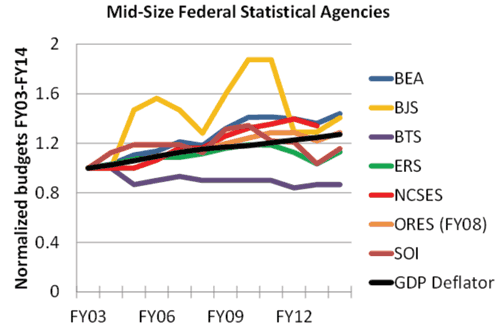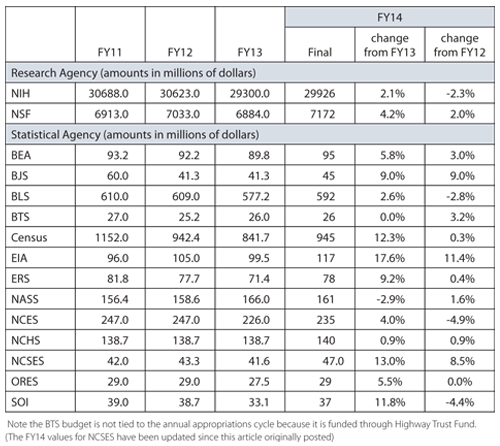NIH, NSF, Statistical Agencies Receive Final FY14 Budgets
This column is written to inform ASA members about what the ASA is doing to promote the inclusion of statistics in policymaking and the funding of statistics research. To suggest science policy topics for the ASA to address, contact ASA Director of Science Policy Steve Pierson at pierson@amstat.org.
Steve Pierson earned his PhD in physics from the University of Minnesota. He spent eight years in the physics department of Worcester Polytechnic Institute before becoming head of government relations at the American Physical Society.
Just over three months into the current fiscal year, Congress and the president finalized the fiscal year 2014 (FY14) budgets, a move facilitated by the December budget deal easing sequestration for both FY14 and FY15. In most cases, the FY14 budget levels are welcome news, as they largely restore the FY13 cuts (see Table 1).
NIH and NSF
While the budget for NIH was increased 2% over the FY13 level, the budget was still 2% below the FY11 and FY12 levels, accentuating the funding challenges NIH has faced for several years withrelatively flat budgets and declining purchasing power due to inflation. Indeed, according to an analysis from the Federation of American Societies for Experimental Biology (FASEB), the NIH FY13 budget was $6 billion (22.4%) less than it was in FY03 in inflation-adjusted dollars. The FASEB analysis also reported 2,110 (20.3%) fewer competing research project grants and 2,528 (34%) fewer R01-equivalent grants than in FY03. Further, proposal funding rates for R01-equivalent grants has declined from 30% in FY03 to 17% in FY13. I would expect the FY14 NIH budget to preventfurther decline in the proposal funding rate.
The NSF budget was increased 4% over the FY13 level, but only 2% over FY12. In FY13, the proposal funding rate was 22%, down from 24% in FY12, but still within the 22%–26% range since FY04 (excluding FY09, when the stimulus allowed a 32% funding rate). It also should be noted that the median annual grant size at NSF has increased each year, from $73,000 in FY04 to $117,000 in FY13. For the Division of Mathematical Sciences (DMS), the funding rates for FY04–FY13 are mostly in the range of 30%–36%. The DMS median grant size, however, rose from $39,000 in FY04 to a peak of $62,000 in FY12, falling to $59,000 in FY13. The FY14 budget should allow NSF to maintain a proposal funding rate of about 22%.
Statistical Agencies
The federal statistical agencies generally had their budgets raised for FY14 to levels above their FY12 budgets. The exceptions are the Bureau of Labor Statistics (BLS) and National Center for Education Statistics (NCES), whose FY14 budgets are 3% and 5% below their FY12 levels, respectively.
The Bureau of Justice Statistics (BJS) and Energy Information Administration (EIA) saw the biggest increases, with 9% and 11% increases over their FY12 levels, respectively. (BJS is still 25% below its FY10 and FY11 levels, when Congress was funding the improvement of the National Crime Victimization Survey.)
Relative to the FY14 administration request (not shown in Table 1), EIA, the Economic Research Service (ERS), and the National Agricultural Statistics Service (NASS) did the best, with Congress funding the request level to within 1%. BJS, NCES, and the National Center for Health Statistics (NCHS) fared the worst, with FY14 levels 15%, 9%, and 13% below their request levels, respectively.
The NCHS budget is perhaps affected the most of the federal statistical agencies as, according to a Friends of NCHS email, Congress did not provide funding from the mandatory Prevention and Public Health Fund established by the Affordable Care Act. For the past two years, this funding has elevated NCHS’s budget by approximately $30 million. As a result, NCHS faces an effective cut of $30 million in FY14.
The U.S. Census Bureau’s budget was increased 12% over FY13, and only 4% below its FY14 request level. Considering the Census Bureau’s budget was funded more than 10% below its request level, the FY14 final budget is welcome news, but the Census Bureau will still need to make difficult choices as it ramps up work on the 2020 decennial census.
To put the FY14 budgets into perspective, figures 1 and 2 show the federal statistical agency budgets normalized to their FY03 budgets. For the mid-size federal statistical agencies, the recent cuts to the ERS budget, the longer-term stagnancy of the Bureau of Transportation Statistics (BTS) budget, and the volatility of the BJS budget stand out. While the BEA has fared well over the 12 years covered in Figure 1, it should be noted that their purchasing power has declined slightly.

Figure 1. The budgets of the seven mid-sized statistical agencies normalized to their FY03 levels, along with the GDP deflator to account for inflation. The Social Security Administration Office of Research, Evaluation, and Statistics’ budget is normalized (and adjusted for inflation) to its FY08 level, when the current accounting scheme was implemented.
For the larger federal statistical agencies (Figure 2), the Census Bureau budget stands out because of both the decennial census and the apparent budget increase over the last decade. For the latter, it is important to remember that the long form of the census was converted from a once-a-decade survey to a monthly rolling survey in the 2000s. That change accounts for the seemingly much larger budget of the Census now than a decade ago.

Figure 2. The budgets of the six larger statistical agencies normalized to their FY03 level, along with the GDP deflator to account for inflation. The NCHS annual budgets are normalized (and adjusted for inflation) to the FY05 level, when the current accounting scheme was implemented. The U.S. Census Bureau line peaks at 12.65 in FY10.
The increase for EIA also stands out, though its FY14 level also could be seen as on track with its FY09 and FY10 budgets. The NCHS budget has been flat since FY10 and has lost about 10% of its purchasing power, thereby making the de facto cut discussed above all the more concerning.
For further discussion about the federal statistical agencies, please see the June 2013 Amstat News article, “Congress Finalizes FY13 Budgets.”
The FY15 federal budget process will begin with the administration’s request, expected early this month.


















